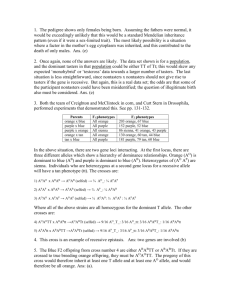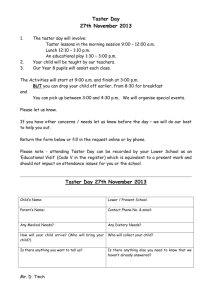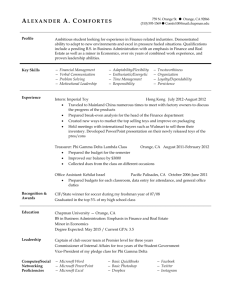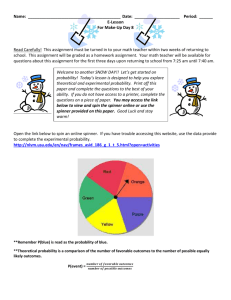Zoo/Bot 3333
advertisement
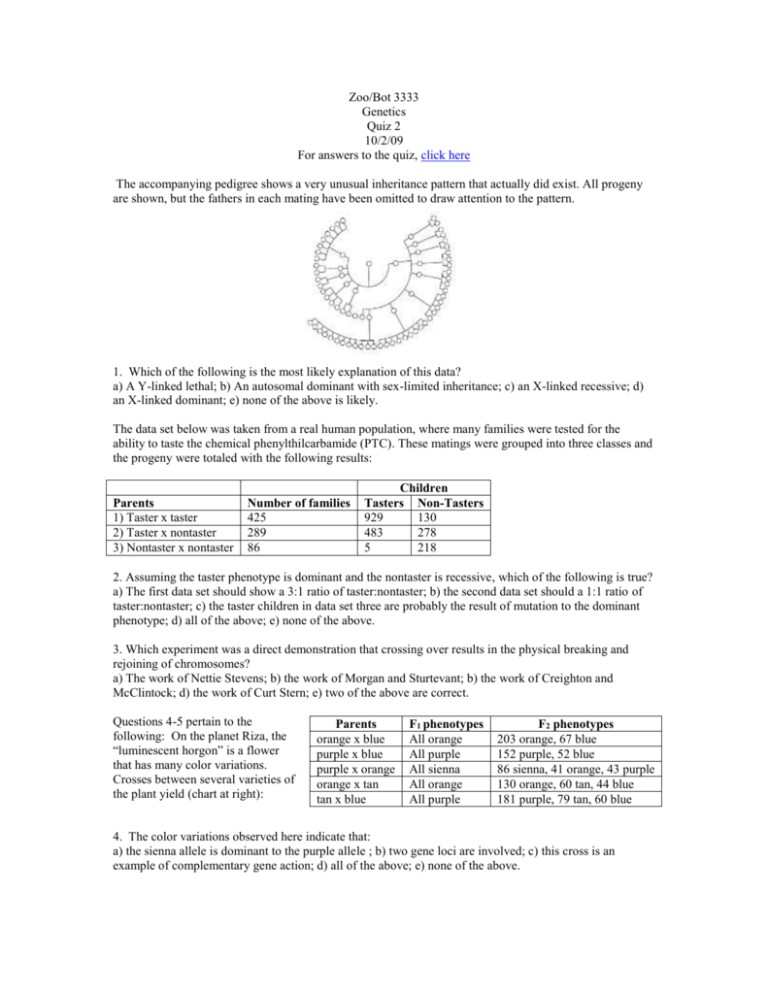
Zoo/Bot 3333 Genetics Quiz 2 10/2/09 For answers to the quiz, click here The accompanying pedigree shows a very unusual inheritance pattern that actually did exist. All progeny are shown, but the fathers in each mating have been omitted to draw attention to the pattern. 1. Which of the following is the most likely explanation of this data? a) A Y-linked lethal; b) An autosomal dominant with sex-limited inheritance; c) an X-linked recessive; d) an X-linked dominant; e) none of the above is likely. The data set below was taken from a real human population, where many families were tested for the ability to taste the chemical phenylthilcarbamide (PTC). These matings were grouped into three classes and the progeny were totaled with the following results: Parents 1) Taster x taster 2) Taster x nontaster 3) Nontaster x nontaster Number of families 425 289 86 Children Tasters Non-Tasters 929 130 483 278 5 218 2. Assuming the taster phenotype is dominant and the nontaster is recessive, which of the following is true? a) The first data set should show a 3:1 ratio of taster:nontaster; b) the second data set should a 1:1 ratio of taster:nontaster; c) the taster children in data set three are probably the result of mutation to the dominant phenotype; d) all of the above; e) none of the above. 3. Which experiment was a direct demonstration that crossing over results in the physical breaking and rejoining of chromosomes? a) The work of Nettie Stevens; b) the work of Morgan and Sturtevant; b) the work of Creighton and McClintock; d) the work of Curt Stern; e) two of the above are correct. Questions 4-5 pertain to the following: On the planet Riza, the “luminescent horgon” is a flower that has many color variations. Crosses between several varieties of the plant yield (chart at right): Parents orange x blue purple x blue purple x orange orange x tan tan x blue F1 phenotypes All orange All purple All sienna All orange All purple F2 phenotypes 203 orange, 67 blue 152 purple, 52 blue 86 sienna, 41 orange, 43 purple 130 orange, 60 tan, 44 blue 181 purple, 79 tan, 60 blue 4. The color variations observed here indicate that: a) the sienna allele is dominant to the purple allele ; b) two gene loci are involved; c) this cross is an example of complementary gene action; d) all of the above; e) none of the above. 5. If the blue F2 offspring from cross 4 are crossed to a true-breeding orange strain, what will be the ratio of progeny? a) all orange; b) 1 orange: 1 blue; c) 3 orange: 1 blue; d) all sienna; e) none of the above. Questions 6-7 pertain to the following cross. A fly heterozygous for three different genes (AaBbCc) is testcrossed to a fly homozygous recessive for these three mutations. The following progeny types are produced (chart at right): 6. The distance between the a and b genes is: a) 8.05 map units; b) 14.2 map units; c) 15 map units; d) 15.3 map units; e) 16.1 map units. Phenotype +bc a+c abc ++c a++ ab+ +++ +b+ Number of progeny 436 91 6 92 440 87 8 98 7. True or false. Only about 1.1% of the expected double crossovers are observed in this cross. Questions 8-9 pertain to the following cross. A fly heterozygous for three different genes (AaBbCc) is testcrossed to a fly homozygous recessive for these three mutations. The following progeny types are produced (chart at right): 8. True or false. The a and c genes are in the trans phasing configuration in the heterozygous parent. 9. The above data set indicates that the c gene is: a) unlinked to the a gene; b) linked to the b gene; c) 3.9 map units from the b gene; d) all of the above; e) none of the above. Phenotype +bc a+c abc ++c a++ ab+ +++ +b+ Number of progeny 228 19 20 234 231 227 21 20 10. The following asci were obtained in Neurosopora when a wild type strain (td+) was crossed to a mutant strain unable to grow in the absence of tryptophan (td-). Spore pair Ascus type 1-2 td+ tdtdtdtd+ 3-4 td+ td+ tdtd+ td5-6 tdtd+ td+ tdtd7-8 tdtdtd+ td+ td+ total 53 7 47 8 5 The distance between the td locus and the centromere is: a) 5.4 map units; b) 8.3 map units; c) 10.8 map units; d) 16.6 map units; e) none of the above.

